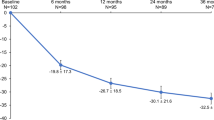Abstract
Purpose
Renal denervation (RDN) emerged as an innovative interventional antihypertensive therapy. With the exception of pretreatment blood pressure (BP) level, no other clear predictor for treatment efficacy is yet known. We analyzed whether the presence of multiple renal arteries has an impact on BP reduction after RDN.
Methods
Fifty-three patients with treatment-resistant hypertension (office BP ≥ 140/90 mmHg and 24-h ambulatory BP monitoring (≥130/80 mmHg) underwent bilateral catheter-based RDN. Patients were stratified into one-vessel (OV) (both sides) and at least multivessel (MV) supply at one side. Both groups were treated on one vessel at each side; in case of multiple arteries, only the dominant artery was treated on each side.
Results
Baseline clinical characteristics (including BP, age, and estimated glomerular filtration rate) did not differ between patients with OV (n = 32) and MV (n = 21). Office BP was significantly reduced in both groups at 3 months (systolic: OV −15 ± 23 vs. MV −16 ± 20 mmHg; diastolic: OV −10 ± 12 vs. MV −8 ± 11 mmHg, both p = NS) as well as 6 months (systolic: OV −18 ± 18 vs. MV −17 ± 22 mmHg; diastolic: OV −10 ± 10 vs. −10 ± 12 mmHg, both p = NS) after RDN. There was no difference in responder rate (rate of patients with office systolic BP reduction of at least 10 mmHg after 6 months) between the groups.
Conclusion
In patients with multiple renal arteries, RDN of one renal artery—namely, the dominant one—is sufficient to induce BP reduction in treatment-resistant hypertension.

Similar content being viewed by others
References
Atherton DS, Deep NL, Mendelsohn FO (2012) Micro-anatomy of the renal sympathetic nervous system: a human postmortem histologic study. Clin Anat 25:628–633
Calhoun DA, Jones D, Textor S et al (2008) Resistant hypertension: diagnosis, evaluation, and treatment: a scientific statement from the American Heart Association Professional Education Committee of the Council for High Blood Pressure Research. Circulation 117:e510–e526
Esler MD, Krum H, Sobotka PA et al (2010) Renal sympathetic denervation in patients with treatment-resistant hypertension (The Symplicity HTN-2 Trial): a randomised controlled trial. Lancet 376(9756):1903–1909
Kandzari DE, Bhatt DL, Sobotka PA et al (2012) Catheter-based renal denervation for resistant hypertension: rationale and design of the Symplicity HTN-3 Trial. Clin Cardiol 35:528–535
Kearney PM, Whelton M, Reynolds K et al (2005) Global burden of hypertension: analysis of worldwide data. Lancet 365(9455):217–223
Krum H, Schlaich M, Whitbourn R et al (2009) Catheter-based renal sympathetic denervation for resistant hypertension: a multicentre safety and proof-of-principle cohort study. Lancet 373(9671):1275–1281
Lorenz EC, Vrtiska TJ, Lieske JC et al (2010) Prevalence of renal artery and kidney abnormalities by computed tomography among healthy adults. Clin J Am Soc Nephrol 5:431–438
Mancia G, De Backer G, Dominiczak A et al (2007) 2007 guidelines for the management of arterial hypertension: the task force for the management of arterial hypertension of the European Society of Hypertension (ESH) and of the European Society of Cardiology (ESC). J Hypertens 25:1105–1187
Mancia G, Laurent S, Agabiti-Rosei E et al (2009) Reappraisal of European guidelines on hypertension management: a European Society of Hypertension Task Force document. J Hypertens 27:2121–2158
Persu A, Renkin J, Thijs L, Staessen JA (2012) Renal denervation: ultima ratio or standard in treatment-resistant hypertension. Hypertension 60:596–606
Rippy MK, Zarins D, Barman NC et al (2011) Catheter-based renal sympathetic denervation: chronic preclinical evidence for renal artery safety. Clin Res Cardiol 100:1095–1101
Satyapal KS, Haffejee AA, Singh B et al (2001) Additional renal arteries: incidence and morphometry. Surg Radiol Anat 23:33–38
Schlaich MP, Sobotka PA, Krum H et al (2009) Renal sympathetic-nerve ablation for uncontrolled hypertension. N Engl J Med 361:932–934
Schmieder RE, Redon J, Grassi G et al (2012) ESH position paper: renal denervation—an interventional therapy of resistant hypertension. J Hypertens 30:837–841
Symplicity HTN-1 Investigators (2011) Catheter-based renal sympathetic denervation for resistant hypertension: durability of blood pressure reduction out to 24 months. Hypertension 57:911–917
Acknowledgments
We gratefully acknowledge the expert technical assistance of Ulrike Höfer and the assistant personnel of the angiography laboratory.
Conflict of interest
A.S. has received lecture fees from Medtronic Inc., P.A.S. was an employee of Medtronic Inc., and R.E.S. has received grants, performed lectures, and received consultancy fees from Medtronic Inc. The other authors declare that they have no conflict of interest.
Author information
Authors and Affiliations
Corresponding author
Rights and permissions
About this article
Cite this article
Schmid, A., Ditting, T., Sobotka, P.A. et al. Does Renal Artery Supply Indicate Treatment Success of Renal Denervation?. Cardiovasc Intervent Radiol 36, 987–991 (2013). https://doi.org/10.1007/s00270-013-0652-9
Received:
Accepted:
Published:
Issue Date:
DOI: https://doi.org/10.1007/s00270-013-0652-9




